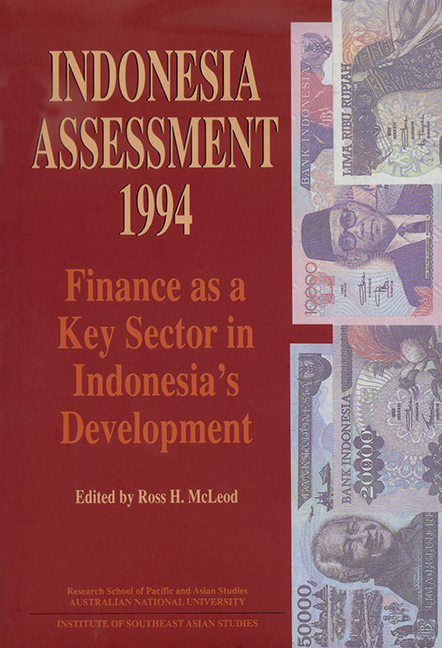Book contents
- Frontmatter
- Contents
- Tables, figures, appendices
- Foreword
- Glossary
- Contributors
- Acknowledgements
- 1 Introduction
- PART A ECONOMIC AND POLITICAL DEVELOPMENTS
- PART B FINANCE AS A KEY SECTOR IN INDONESIA'S DEVELOPMENT
- I The Reform Process
- II Monetary and Exchange Rate Policy
- III Banking Sector Reforms
- IV Domestic and International Capital Markets
- 12 The role of the Indonesian capital market
- 13 Indonesian capital market development and privatisation
- 14 Problems and prospects for the life insurance and pensions sector in Indonesia
- 15 Indonesia's foreign debt
- V Small-scale Finance
- References
- Index
15 - Indonesia's foreign debt
from IV - Domestic and International Capital Markets
Published online by Cambridge University Press: 21 October 2015
- Frontmatter
- Contents
- Tables, figures, appendices
- Foreword
- Glossary
- Contributors
- Acknowledgements
- 1 Introduction
- PART A ECONOMIC AND POLITICAL DEVELOPMENTS
- PART B FINANCE AS A KEY SECTOR IN INDONESIA'S DEVELOPMENT
- I The Reform Process
- II Monetary and Exchange Rate Policy
- III Banking Sector Reforms
- IV Domestic and International Capital Markets
- 12 The role of the Indonesian capital market
- 13 Indonesian capital market development and privatisation
- 14 Problems and prospects for the life insurance and pensions sector in Indonesia
- 15 Indonesia's foreign debt
- V Small-scale Finance
- References
- Index
Summary
Introduction
Fane (this volume) draws attention to the ambivalence of official policy towards integration of Indonesian finance with the world markets. A further indication of this ambivalence is the government's concern about the size of Indonesia's foreign debt, which grew from only 28 per cent of GDP in 1982 to 69 per cent in 1987, and by 1994 was of the order of 65 per cent. As a result of this dramatic but quite unexpected expansion, there are now frequent references in the media to the need for Indonesia to do this or not do that, because of its supposed ‘foreign debt problem’.
This is reflected in various actual or proposed policy responses. A high level ministerial committee was established in 1991 (Government of Indonesia 1991) to control the level of foreign borrowing by state enterprises (including the state banks), as well as that for private projects closely linked to state enterprises and the public sector in general. The Coordinating Minister for Finance and Development has proclaimed the desirability of keeping Indonesia's total foreign debt (now over $90 billion) to below $100 billion. The sale of government shares in various large enterprises to foreigners has been mooted as a way of repaying part of its foreign borrowings. Exchange rate policy is being managed in such a way as to attempt to stimulate non-oil export growth, in order to assist with debt repayment. The recent relaxation of controls on direct foreign investment (Pangestu, this volume) provides greater encouragement for capital inflow to take the form of equity rather than debt (although the government has baulked at loosening the restriction on the level of foreign investment in Indonesian companies listed on the stock exchanges).
There has been little debate on the appropriateness of these policies, and so it is of interest to consider them in the light of the assertions by Little et al.
- Type
- Chapter
- Information
- Indonesia Assessment 1994Finance as a Key Sector in Indonesia's Development, pp. 268 - 290Publisher: ISEAS–Yusof Ishak InstitutePrint publication year: 1994



